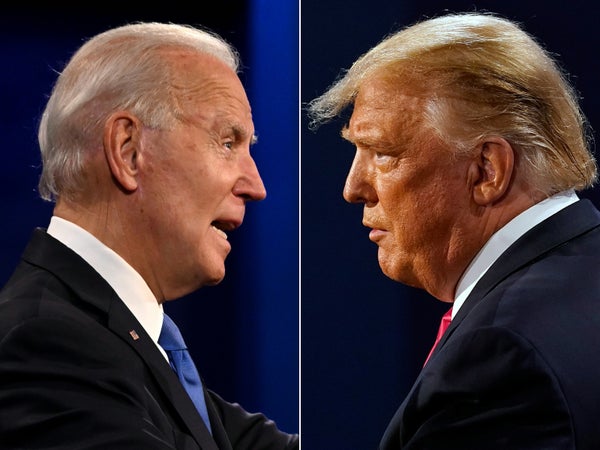Donald Trump may have been more ill than anyone suspected when he checked in at Walter Reed National Military Medical Center on October 2, 2020. The then president, 74 years old at the time, had serious signs of disease in his lungs and low blood oxygen levels. He was quickly started on an aggressive course of treatments, including an intravenous infusion of the antiviral medication remdesivir and a cocktail of monoclonal antibodies.
What a difference these couple of years make. After testing positive for COVID, the fully vaccinated and boosted 79-year-old Joe Biden has been carrying out his presidential duties while isolating at the White House with what have been characterized as mild symptoms. A video of Biden was released at midday on July 21: “I’m doing well, getting a lot of work done, going to continue to get it done,” he said.
“The differences in both the disease course and treatment for COVID in Trump versus Biden is stark,” says Akiko Iwasaki, an immunologist at Yale University, who has worked on vaccine development. It may be obvious to all, but it bears repeating that the most striking difference is that Trump was infected with the virus that causes COVID just before the vaccines against it were available. After a trip to Walter Reed by helicopter, Trump was given a steroid in addition to a course of remdesivir and a high-dose injection of the monoclonal antibody cocktail, the latter an experimental treatment at the time.
On supporting science journalism
If you're enjoying this article, consider supporting our award-winning journalism by subscribing. By purchasing a subscription you are helping to ensure the future of impactful stories about the discoveries and ideas shaping our world today.
In contrast, Biden was fully vaccinated and boosted, and he only received an orally administered antiviral pill. “This shows the incredible benefit of the COVID vaccines, particularly after booster doses, to prevent severe COVID,” Iwasaki says.
The differing courses of the illness among these two men demonstrates the goal of the vaccines’ accelerated development efforts. “It’s a great illustration of exactly what the vaccines are supposed to do,” says Edy Kim, a critical care physician at Brigham and Women’s Hospital in Boston. Kim has seen a marked reduction in patients hospitalized with COVID and an even greater decline in such patients moving into the intensive care unit. “The purpose of the vaccines is not to avoid COVID completely, but if you get COVID, they help you avoid hospitalization,” he says.
The scientists and health care workers who have witnessed these before-and-after time periods marvel at the current protection even for the most vulnerable groups. “In general, people in Biden’s and Trump’s age group are now doing so much better than they were as a result of vaccinations,” says Bill Hanage, an epidemiologist at the Harvard T. H. Chan School of Public Health. And doses matter. In fact, he says “four shots are better than three, and three are very much better than two.”
Just last week the Centers for Disease Control and Prevention reported that, for healthy adults age 50 and older, a second booster prevented hospitalizations caused by the Omicron variant and its subvariants in 80 percent of people, compared with 55 percent in those who only had one booster. “The fact that President Biden is tweeting from the White House, sitting up and fully dressed despite his new COVID diagnosis, is not an accident,” says Peter Hotez, an infectious disease specialist at Baylor College of Medicine.
Hotez credits Biden’s mild illness to his two booster shots against COVID plus his early treatment with the antiviral drug Paxlovid. Although all presidents receive excellent medical treatment, Trump was given an experimental medicine that was not widely available at the time. Biden, on the other hand, is being treated with a drug that can be readily obtained at local pharmacies. “His illness is a reminder for everyone to take full advantage of vaccinations and treatments, which unfortunately is not happening in many parts of the country,” Hotez says.
Hanage also hails the widespread availability of antiviral treatments such as Paxlovid. Today the average of daily new COVID cases tally up to about 126,000, which is nearly three times what they were when Trump’s infection was disclosed in early October 2020. But the current number of average daily deaths is half of what it was at that time. “That’s a huge difference,” Hanage says. “I think that a lot of that is due to the remarkable advances that we’ve made over the last few years and being able to provide people with protection.”
